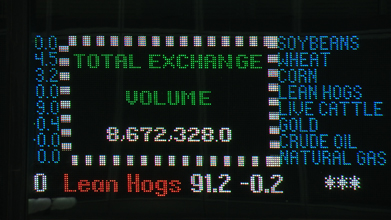
Fictions and Futures
Fictions and Futures #1
“What's fantastic about trading futures today: it's so easy, push the button, buy the bean, I'm in the market, right?” says an analyst. Originally, the basic idea behind futures was that they serve to protect producers and consumers against fluctuations in the price of raw materials. In practice, futures are bets on a future price that are traded on commodity futures exchanges. With the deregulation of financial markets and the introduction of electronic trading, this hedging process became a mass product, largely replacing the purchase and sale of real goods. Banks and funds invested heavily in the future price of basic foods. Online trading firms began to target a completely new kind of customer, the small investor. Anybody can legally participate in the huge casino of the commodity futures market in the hope of making real profits from an abstract contract based on a fictional underlying premise. At the same time, like an invisible hand, futures determine the prices of real food, setting the industrial standards worldwide for agricultural production.
In Fictions and Futures #1, Gloria, the voice of the brokerage firm by the same name, introduces us to the language and logic of the financial world. In her words, and those of her handpicked guests, we find out what narratives fuel the markets, why the scarcity of raw materials is a reason to rejoice, and how an announced catastrophe can be used by special interests to lever an advantage.
Find excerpts from Fictions and Futures #1 and the lecture performance Over the Counter is Under the Table in context.